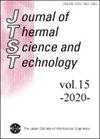乙醇-空气与稀释的热氧化剂在反向射流中再循环轻度燃烧
IF 0.9
4区 工程技术
Q3 THERMODYNAMICS
引用次数: 1
摘要
为了最大限度地减少NOX排放,同时提高燃烧设备的热效率,人们对中强度低氧稀释(MILD)燃烧进行了长期的研究。近年来对轻度燃烧的研究很多,但对乙醇等可再生燃料的轻度燃烧的研究非常少,特别是对乙醇-空气轻度燃烧产生NOX的具体信息尚未见报道。为了满足轻度燃烧的条件,内部再循环是必不可少的,以便将燃烧产物气体带入燃烧系统的空气和燃料射流中。本文利用Ansys软件中的OPPDIF对简化的对置射流几何进行了一系列数值分析。在反应物流动中不同的燃烧气体稀释度条件下,数值分析了再循环比(KV)对形成MILD的乙醇-空气燃烧过程中NOX排放的影响。结果表明,随着再循环比的增大,温度降低,最大放热值也随着再循环比的增大而降低。当燃烧模式改为轻度燃烧模式时,热释放的热解区消失,两个热释放峰合并为一个。本文章由计算机程序翻译,如有差异,请以英文原文为准。
MILD combustion of ethanol-air with diluted hot oxidant by recirculation in opposite jet
Moderate Intensity Low Oxygen Diluted (MILD) combustion has been investigated for a long time in order to minimize NOX emission still enhancing thermal efficiencies in the combustion equipment. Many researches about MILD combustion have been recently performed, but studies on MILD combustion of renewable fuel such as ethanol has been very scarce and particularly, specific information on the NOX production in ethanol-air MILD combustion has not been reported yet. In order to satisfy the condition for MILD combustion, internal recirculation is known to be essential in order to entrain the combustion products gas into air and fuel jets of combustion system. In this work, a series of numerical analysis with simplified opposed jet geometry have been done using the OPPDIF in Ansys program. Numerical analysis on how the recirculation ratio (KV) affects NOX emission in the ethanol-air combustion for MILD formation were carried out under the condition of various burnt gas dilution in reactant flow. The results show that the temperature was decreased by the increase of the recirculation ratio and the maximum heat release value became also low by the increase of the recirculation ratio. It was also found that the pyrolysis zone of the heat release was disappeared and the two heat release peaks are merged into one as combustion pattern is changed to MILD combustion mode.
求助全文
通过发布文献求助,成功后即可免费获取论文全文。
去求助
来源期刊
CiteScore
2.30
自引率
8.30%
发文量
0
审稿时长
5 months
期刊介绍:
JTST covers a variety of fields in thermal engineering including heat and mass transfer, thermodynamics, combustion, bio-heat transfer, micro- and macro-scale transport phenomena and practical thermal problems in industrial applications.

 求助内容:
求助内容: 应助结果提醒方式:
应助结果提醒方式:


